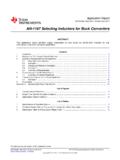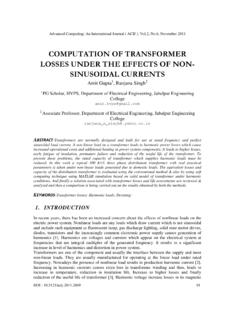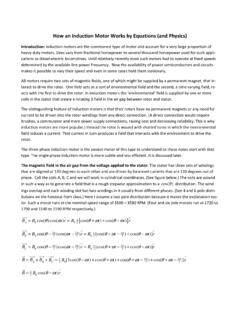Transcription of Design of a TL431-Based Controller for a Flyback ... - Plexim
1 Design of a TL431-Based Controllerfor a Flyback ConverterDr. John Sch nbergerPlexim GmbHTechnoparkstrasse 18005 Z rich1 IntroductionThe TL431 is a reference voltage source that is commonly used in the control circuit of isolated powersupplies. Typically used to provide a precision reference voltage, the TL431 can also be configured as ananalog Controller by exploiting its on-board error amplifier. In this report, the Design of a TL431-basedvoltage Controller for a Flyback converter is presented. The example circuit is shown in Fig. 1. !"" # $ # " " %& ' ()*+, 0 Fig. 1: Schematic of current-controlled Flyback converter with a TL431 configured as a type 2 voltage Flyback converter comprises two control loops. The inner current control loop, based on peak currentmode control, is realized using a UCC38C4x current-controlled PWM modulator.
2 The outer voltage controlloop is a type 2 Controller , which is commonly used in power supply voltage control loops. The voltagecontrol circuit regulates the output voltage of the 5 V winding and includes an optocoupler to maintainisolation between the input and output voltage Controller must regulate the measured 5 V output voltage over a range of loading conditionson the 12 V windings, which induce voltage deviations on the 5 V winding . The load resistances on the 12 V windings vary between 15 and . The starting point for the voltage Controller Design is thecalculation of the converter s open-loop transfer function,Vo(s)Vc(s), which is depicted as a Bode plot. The type2 Controller is then designed in the frequency domain to ensure that it provides a sufficiently fast andstable closed-loop transient 12-11 Design of a TL431 Controller using PLECS Fig.
3 2: Use of the TL431 to generate an arbitrary reference this report, an example Design and verification procedure for a TL431-Based type 2 voltage controlleris presented. PLECS small-signal analysis tools are employed to calculate the open and closed-loop Bodeplots of the system. Example models accompany this report to illustrate the use of the PLECS small-signal analysis tools and to demonstrate the operation of the complete system. These models can be foundin the The The TL431 regulatorThe TL431 is an adjustable shunt regulator that can be configured to provide an arbitrary referencevoltage as shown in Fig. 2. The output voltage can be set to any value betweenVrefand 36 V using twoexternal resistors. The output voltage is given byVo=Vref 1+R1R2 (1)whereVrefis the onboard V reference voltage The TL431 type 2 error amplifierAlthough the TL431 is commonly used as an adjustable voltage reference source, its onboard error am-plifier can be configured as an op-amp, allowing it to be used for both voltage reference and control ap-plications.
4 The 1 MHz unity-gain bandwidth of its error amplifier is more than adequate for most powersupply voltage control frequency response of a type 2 Controller is depicted as a Bode plot in Fig. 3. At low frequencies, thetype 2 Controller is similar to a PI Controller , having a pole at 0 due to the integral action, and a zeroat zdue to the proportional action. However, the type 2 Controller includes a high frequency pole at p,which is used to mitigate the switching ripple. The transfer function of a type 2 Controller is given asfollows:C(s)=kp 1+s s 11+sT (2)=kp1+s s2 T+s (3)It can be seen from Fig. 3 that the type 2 Controller is characterized by three parameters: the gain,Av,the zero frequency, z, and the pole frequency, p.
5 These parameters are used to calculate the terms inthe transfer function as follows:kp= 10Av20(4)J. Sch nberger, Plexim GmbH2 Design of a TL431 Controller using PLECSFig. 3: Bode plot of type 2 Controller . =1 z(5)T=1 p(6)The TL431 is shown configured as a type 2 Controller in Fig. 4. The Controller circuit, shown in (a), includes an optocoupler to provide isolated feedback. A single pullup resistor or a resistive dividercomprisingRc1,Rc2can be used to generate the control voltage,Vc. A resistive divider allows a maximumlimit forVcto be set, which is useful for limiting the startup current. The equivalent small-signal collectorresistance,Rc, is equivalent toRc1|| block diagram of the complete system is shown in Fig. 4(b).
6 It can be seen that the TL431 controlcircuit includes a reference voltage source and summer in addition to the type 2 Controller ,C(s).In the TL431-Based type 2 control circuit, the proportional gain is given bykp=CTRRcRled(7)whereCTRis the current transfer ratio of the optocoupler andRcis the effective small-signal collectorresistance that is formed from the parallel combination ofRc1andRc2. The pull-down resistorRc2isoptional. If included, it limits the peak control voltage, in turn limiting the peak MOSFET low frequency pole is set by the componentsR1,C1: z=1R1C1(8)The high frequency pole is set by the componentsRc,Cp: p=1 RcCp(9)It is assummed thatCpis much larger thanCopto, the output capacitance of the IC modelingThree ICs are included in the Flyback converter model: the TL431 reference voltage source, the UCC38C4xcurrent mode Controller and the optocoupler.
7 These are modeled in PLECS using simplified Sch nberger, Plexim GmbH3 Design of a TL431 Controller using PLECS (a) Controller circuit with optocoupler for feedback loop isolation. (b) System block 4: The TL431 configured as an isolated type 2 Controller .(a) small-signal voltage gain. (b) PLECS 5: TL431 TL431 modelA practical TL431 contains an error amplifier and a V reference voltage source [1]. The PLECS modelof the TL431 is shown in Fig. 5. The small-signal voltage gain is approximated using a first-order low-pass filter with a gain of 750 ( dB) and a cutoff frequency of kHz. The Bode plot of the small-signalvoltage gain of the error amplifier is shown in Fig. 5(a). It can be seen that the unity-gain frequency isapproximately 2 should be noted that the unity-gain frequency of the practical TL431 component is 1 MHz because thepractical component does not have a true first-order characteristic.
8 However, this difference has negligibleimpact on the system model, since the cutoff frequency of the control system is approximately three ordersof magnitude lower than the unity gain frequency of the cathode current vs. voltage characteristic of the TL431 has an offset of since the minimumcathode voltage that can be generated is equal to the reference voltage. The cathode offset voltage ismodeled in PLECS using an ideal diode as shown in Fig. 5(b). Due to use of the ideal diode, the offsetvoltage is , even at zero current. In a practical TL431, the cathode offset voltage is not guaranteed tobe V unless the cathode current is 1 mA. Therefore the TL431 should be correctly biased to ensure thevalidity of the Sch nberger, Plexim GmbH4 Design of a TL431 Controller using PLECS !
9 ! "# # " # $ % &'()*(a) Simplified behavioral model. (b) Actual current reference offset and 6: PLECS model of the UCC38C4x current-mode control IC. Fig. 7: PLECS optocoupler UCC38C4x current-mode control IC modelThe current Controller model is based on the UCC38C4x series of current-mode PWM contol ICs [2]. In-ternally, the UCC38C4x modulator consists of a peak current mode Controller , oscillator, error amplifier,reference voltage generator, undervoltage lockout logic and current offset and scaling circuit. The simpli-fied behavioral model of the UCC38C4x is shown in Fig. seen in Fig. 6(a), the simplified behavioral model contains only those features that directly influencethe operation of the control circuit and converter.
10 These features are the peak current mode Controller ,current offset and scaling circuit and the 5 V reference voltage. The onboard error amplifier is not modeledsince the control voltage is supplied by the external type 2 control actual current reference offset and scaling circuit found between the COMP pin andIrefinput of thepeak current Controller is shown in Fig. 6(b). The current sense circuit comprises a voltage drop of Vand a resistive voltage divider. The peak MOSFET current is therefore expressed as:Isw=max(Vc ,0)3Rs(10)whereRsis the current sense resistor that is connected in series with the Optocoupler modelThe optocoupler is modeled using a controlled current source as shown in Fig. 7. In the linear operatingregion, the collecter current is given byIc=CTR Iled.








